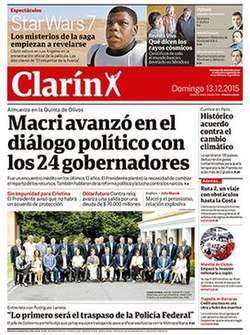Clarín (Argentine newspaper)
Clarín (Spanish pronunciation: [klaˈɾin], meaning "Bugle"), is the largest newspaper in Argentina, published by the Grupo Clarín media group. It was founded by Roberto Noble in 1945.[8][9]
 Front page of Clarín from 13 December 2015 | |
| Type | Daily newspaper |
|---|---|
| Format | Tabloid |
| Owner(s) | Clarín Group |
| Editor | Ricardo Kirschbaum |
| Founded | 1945 |
| Political alignment | Centrism[1][2][3][4][5] Formerly: Developmentalism[6] |
| Headquarters | Buenos Aires, Argentina |
| Circulation | 270,444 (Print, 2012) 100,000 (Digital, 2018)[7] |
| Website | Clarin.com |
For many years, its director was Ernestina Herrera de Noble, the founder's wife.[10]
Clarín is part of Periódicos Asociados Latinoamericanos (Latin American Newspaper Association), an organization of fourteen leading newspapers in South America.
History
Clarín was created by Roberto Noble, former minister of the Buenos Aires Province, on 28 August 1945. It was one of the first Argentine newspapers published in tabloid format. It became the highest sold Argentine newspaper in 1965, and the highest sold Spanish-speaking newspaper in 1985. It was also the first Argentine newspaper to sell a magazine with the Sunday edition, since 1967. In 1969, the news were split into several supplements by topic. In 1976, high colour printing was benefited by the creation of AGR.
For many years the Argentine author Horacio Estol was the New York correspondent of Clarin, writing about aspects of US life of interest to Argentines.[11]
Roberto Noble died in 1969, and his widow Ernestina Herrera de Noble succeeded him as director. The newspaper bought Papel Prensa in 1977, together with La Nación and La Razón. In 1982, it joined a group of 20 other newspapers to create the "Diarios y Noticias" informative agency. The Sunday magazine was renamed in 1994 to "Viva", a name that would last up to modern day. The newspaper started a media conglomerate in 1999 after a law reformation which allows it to collect many different media supports, that would be named after the newspaper, Grupo Clarín. This conglomerate would operate in radio, television, Internet, other newspapers and other areas beyond Clarín itself.
On 27 December 1999, The Clarín Group and Goldman Sachs, an American investment firm, subscribed an investment agreement where the consortium, managed by Goldman Sachs, made a direct investment in Clarín Group. The operation implied an increase of capital to the Clarin Group and the incorporation of Goldman Sachs as minority partner, with a participation of 18% of the stocks.
Clarín launched clarin.com, the website for the newspaper, in March 1996. The site served nearly 6 million unique visitors daily in Argentina in April 2011, making it the fifth most visited website in the country that month and the most widely visited of any website based in Argentina itself.[12]
There was a conflict between the government of Fernández de Kirchner and the Clarín Group from 2008 until 2015 over a variety of issues. The Clarín Group is the biggest media holding in Argentina, not only publishes the Clarín newspaper but also owns the country major cable operator Cablevisión, a major commercial broadcast television Canal 13, a number of cable networks, and hundreds of radio licenses.
Circulation
Clarín prints and distributes around 330,000 copies throughout the country, but by 2012, circulation had declined to 270,444 copies and Clarín accounted for nearly 21 percent of Argentine newspaper market, compared to 35 percent in 1983.[7] Clarín has a 44 percent market share in Buenos Aires.
According to third-party web analytics providers Alexa and SimilarWeb, Clarín's website is the 10th and 14th most visited in Argentina respectively, as of August 2015.[13][14] SimilarWeb rates the site as the 3rd most visited news website in Argentina, attracting almost 32 million visitors per month.[14][15]
Gallery
 Cover to Clarín #1, 28 August 1945.
Cover to Clarín #1, 28 August 1945. Former Argentine president Cristina Kirchner holding a Clarín newspaper in 2011.
Former Argentine president Cristina Kirchner holding a Clarín newspaper in 2011.
See also
References
- https://www.clarin.com/opinion/verdadero-progresismo-liberal_0_lCwLLsuE6.html
- https://www.clarin.com/opinion/mundo-liberal-conservador_0_axIeEA6.html
- https://www.clarin.com/opinion/liberalismo-vs-populismo_0_sJkiBAcv.html
- https://www.clarin.com/opinion/liberalismo-preocupa-desigualdad_0_BJJ-xkijPXe.html
- https://www.clarin.com/revista-enie/ideas/liberalismo-reduce-libre-mercado_0_rJOyIVxal.html
- https://dialnet.unirioja.es/descarga/articulo/7442024.pdf
- "Clarín vende un 32% menos que en 2003 y reduce su presencia en el mercado de diarios (Clarin sells 32% less than in 2003 and reduced its presence in the market daily)". Telam. 30 August 2013. Retrieved 18 February 2014.
- "Pressed". The Economist. 25 August 2010.
- http://www.grupoclarinsustentable.com/contenidos-con-valor/nuestros-valores/
- "Origin and Evolution". grupoclarin.com. Grupo Clarín. Archived from the original on 19 January 2015. Retrieved 19 January 2015.
- "After Half a Century and 200 Issues ..." Automóvil Club Argentino. Archived from the original on 25 July 2011. Retrieved 26 October 2011.
- "Facebook Users in Argentina Spend 9 Hours a Month on Site, Second Only to Israel in User Engagement". comScore. 9 June 2011.
- "clarin.com Site Overview". Alexa. Retrieved 2 August 2015.
- "Clarin.com Analytics". SimilarWeb. Retrieved 2 August 2015.
- "Top 50 sites in Argentina for News And Media". SimilarWeb. Retrieved 2 August 2015.
External links
| Wikimedia Commons has media related to Clarín. |
- clarín.com
- Grupo Clarin
- The Holding (in Spanish)
- Clarín's Profile
- Info America (in Spanish)
- El Trece
- Gran DT